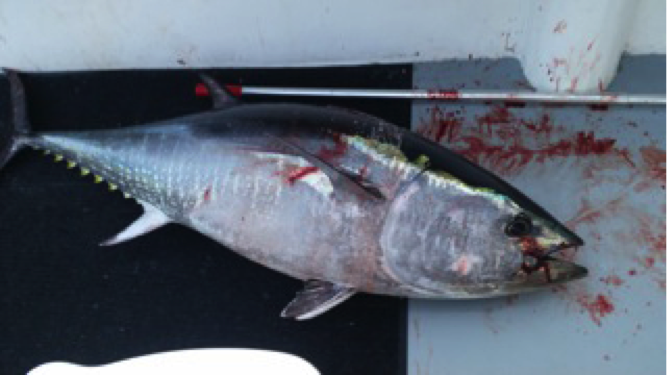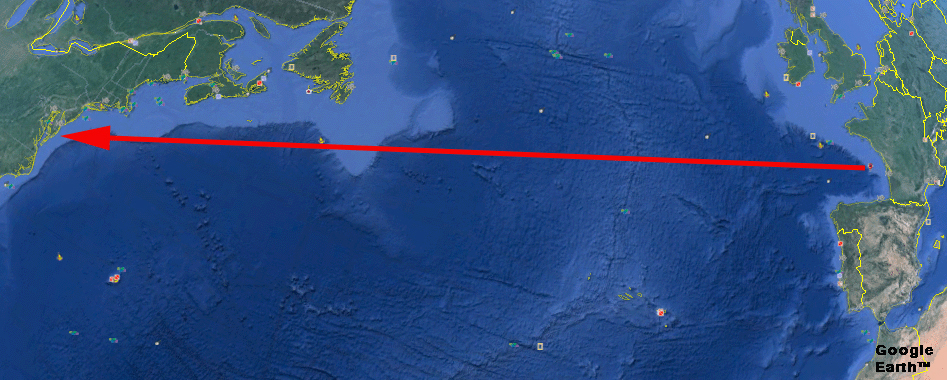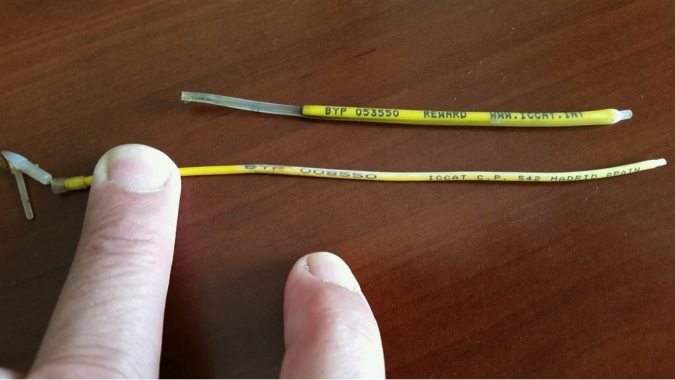By Mitchell A. Roffer, Ph.D. | Originally Published July 1, 2015.
Captain Johnny Oughton (J & A Charters) coming out of Ocean City, MD on June 23, 2015 on daily charter with angler Brian Wilson (Sumter, SC) fishing approximately 40 miles east of the inlet. Caught a surprise. Brian reported “there were many bluefin tuna in the area, we hooked two others, one bigger and one smaller. The boat next to us hooked five at once but they were all smaller. The tuna were feeding on schools of sand eels. There was also a large humpback whale swimming right over our catch. I actually thought I was going to lose the fish because the whale went right over him during the fight. Pretty Spectacular! Seas were gentle 2 to 4 foot waves. Early morning bite.”

Figure 1. Atlantic bluefin tuna that had the tags
The great surprise was that one of the bluefin tuna had two yellow spaghetti tags attached. After being landed they realized that the tags were from the International Commission for the Atlantic Tunas (ICCAT). One fish tag recapture is special, but two is spectacular. After communicating with Antonio Di Natale (Ph.D.), the GBYP Coordinator from the Atlantic-Wide Research Programme on Bluefin Tuna in Spain, we learned that the fish had originally been tagged July 07, 2012 in the Bay of Biscay, Spain and was 24.4 inches and weighed approximately 11 lbs. when tagged by an ICCAT GBYP contractor. This fish was swimming for three years with these tags. When recaptured the fish measured 54 inches and weighed 93 lbs. The fish grew 28.3 inches in three years which is 9.4 inches per year and gained 82 lbs. which translates to an average 27 lbs. per year. While we do not know the path of the fish, an near straight line estimate is approximately 4,700 miles from tag to recapture. This is the minimum distance that the fish traveled. We also not know how many times this wonderful fish crossed the Atlantic Ocean or if this was the first time.
Figure 2. Possible path from Bay of Biscay, Spain to Ocean City, MD.
This fish and tags are very important for understanding the rate of trans-Atlantic migration and for understanding tag shedding rates. Many times fish are tagged and the tag comes off the fish, even though it is tagged in the fish’s muscle. From the photo of the tags one can see that they are slightly different tags and probably had different arrow head attachment devices. Captain Oughton could easily cut the entire tag with head from the fish, while the other tag head could not be easily removed. However, Captain John indicated that the tag heads were the same on both tags.
Figure 3. The two tags after they were removed from the fish and cleaned.
If you are lucky enough to catch a tagged fish, ICCAT and NOAA National Marine Fisheries Service, Southeast Fisheries Science Center, Miami, FL (Eric Orbesen or Derke Snodgrass) need the following essential data: 1) position of the recover; 2) size of the fish (straight forked length or curved forked length); 3) sex; and 4) fishing gear. In this case it was rod and reel. Reward for a tag is 100 Euros or two GBYP t-shirts. Also if you catch a tagged fish, but want to release it, please take as much information from the tag and fish as possible. If you have another tag, then go ahead an put another tag in the fish safely and report it to NMFS. For ICCAT tags see http://iccat.int/en/Tag-Recov.htm and for the NMFS Cooperative Tagging Program see http://www.sefsc.noaa.gov/species/fish/tagging.htm. NMFS works with the Billfish Foundation to enhance billfish tagging efforts throughout the Atlantic Ocean and beyond. We encourage you to start tagging fish you release as we need so much more information about all the fish in the ocean.
We congratulate Captain John Oughton and Brian Wilson for their fine work and luck and thank NMFS and ICCAT for their work. As a postscript we received a note on July 1, 2015 from Derke Snodgrass (NMFS, Miami, FL): “An interesting story that has been created here is that same day a bigeye tuna that was tagged last October (on the US side of the Atlantic Ocean) was recaptured that same day (6/23/15) over in the east Atlantic. So on the same day we had recaptures of tuna going opposite directions across the Atlantic Ocean.”







